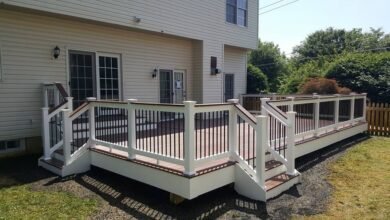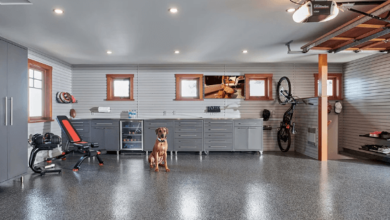How to Maintain Your Deck for Longevity?

To ensure your deck stands the test of time, regularly inspect for loose or damaged boards, tighten fasteners, and check for pests. Clean the deck thoroughly at least twice a year using a commercial or homemade cleaner. Seal and stain the deck to protect it against weather and water damage. Address any repairs promptly, replacing warped or damaged boards and ensuring proper drainage.
Prevent insect infestations by keeping the area free of debris and using high-quality sealant. Maintaining hardware and protecting the deck from extreme weather will further extend its life. By following these steps, you’re well on your way to a long-lasting deck.
Inspect Regularly
Regularly inspecting your deck helps catch potential problems early, saving you time and money in the long run.
Begin by checking for any loose or damaged boards by Mackay Patio Concepts. Walk around and feel for any uneven surfaces or areas that give under pressure. Loose boards can be a tripping hazard and indicate underlying structural issues.
Next, examine the railings and stairs. Give them a firm shake to ensure they’re secure. Wobbly railings and steps aren’t only unsafe but can deteriorate more quickly if not fixed promptly. Also, look for signs of rot, especially in places where the wood meets the ground or is frequently exposed to water.
Don’t forget to inspect the fasteners. Screws, nails, and bolts can loosen over time, leading to instability. Tighten any that seem loose and replace any that are rusted or damaged. It’s a simple task that can prevent more significant problems down the line.
Lastly, check for any signs of pests, such as termites or carpenter ants. These critters can cause severe damage if left unchecked. Regular inspections will help you catch their presence early, allowing for swift action to protect your deck.
Clean Thoroughly
Once you’ve inspected your deck, it’s important to clean it thoroughly to maintain its appearance and longevity.
Start by removing any furniture, plants, and debris. Sweeping the surface will help you get rid of loose dirt and leaves.
For a deeper clean, you’ll need a deck cleaner. You can choose between a commercial cleaner or a homemade solution like a mix of water and mild detergent.
Apply the cleaner using a garden sprayer or a paint roller. Scrub the surface with a stiff-bristle brush, focusing on areas with mold, mildew, or stains. Pay special attention to corners and crevices where dirt tends to accumulate.
Rinse the deck thoroughly with a garden hose to remove all the cleaning solution and grime.
For stubborn stains or really dirty decks, a pressure washer can be very effective. However, use it with caution to avoid damaging the wood. Keep the nozzle at least a foot away from the surface and use a fan tip for a gentler spray.
Seal and Stain
After cleaning, sealing, and staining your deck is crucial to protect it from the elements and enhance its appearance. Start by choosing a high-quality sealant and stain that suits your deck’s material. A clear sealant preserves the wood’s natural color, while a tinted stain can add color and extra UV protection.
Apply the sealant first. Use a brush, roller, or sprayer to ensure an even coat. Work in small sections to prevent the sealant from drying unevenly. Make sure to cover all surfaces, including railings and stairs. Allow the sealant to dry completely, which can take up to 48 hours, depending on the weather.
Once sealed, it’s time to stain. Stir the stain thoroughly before application. Apply it similarly to the sealant, using a brush, roller, or sprayer. Make sure to work the stain into the wood grain and cover all areas evenly. Avoid puddles and drips by spreading the stain consistently. Let the stain dry according to the manufacturer’s instructions, typically around 24-48 hours.
Fix Loose Boards
Even if your deck is well-maintained, loose boards can still pose a safety hazard and should be fixed promptly. Start by inspecting your deck thoroughly to identify any loose boards. Walk across the entire surface, paying close attention to areas that feel unstable or make noise when stepped on.
Once you’ve identified loose boards, gather your tools: a hammer, deck screws, and a power drill. For boards that have only slightly loosened, driving a few screws into the joist below them should do the trick. Make sure you use screws specifically designed for decking, as they’re more resistant to outdoor conditions.
If a board is particularly warped or damaged, it may need to be replaced entirely. Remove the old board by unscrewing or prying it up carefully to avoid damaging surrounding boards. Measure and cut a new board to fit the space, then secure it with screws.
Regularly checking and tightening any loose boards will help keep your deck safe and looking great. It’s a straightforward task that significantly contributes to the overall longevity of your outdoor space. Don’t wait until it becomes a bigger problem—address it as soon as you notice any issues.
Address Water Damage
Addressing loose boards is vital, but tackling water damage is equally important to maintain your deck’s integrity. Water damage can lead to rot, mold, and structural issues if left unchecked. Here’s how you can proactively address water damage and ensure your deck remains in top shape.
- Inspect Regularly: Check your deck for signs of water damage, such as discoloration, soft spots, or mold. Pay special attention to areas where water might pool or where the deck meets the house.
- Seal Your Deck: Applying a water-resistant sealant can help protect your deck from moisture. Make sure to reapply the sealant every couple of years or as recommended by the manufacturer.
- Ensure Proper Drainage: Make sure your deck has proper drainage to prevent water from pooling. This might involve cleaning the spaces between deck boards or adjusting the slope of your deck.
- Repair Damaged Areas: If you find any areas of your deck that have already been affected by water, address them immediately. Replace any rotten boards and treat the affected areas with a wood preservative to prevent further damage.
Prevent Insect Infestation
Insects can wreak havoc on your deck, so taking steps to prevent infestations is crucial for maintaining its longevity. Start by choosing pressure-treated wood or naturally insect-resistant materials like cedar or redwood. These materials are less appealing to pests.
Regularly clean your deck to remove food particles and organic debris that attract insects. Sweep away leaves, branches, and dirt, and wash the surface with a deck cleaner.
Seal your deck with a high-quality sealant every few years. This creates a barrier that helps keep moisture and insects out. Inspect the wood for signs of infestation such as holes, sawdust, or frass, and address any issues immediately to prevent them from worsening.
You can also use insect repellents specifically designed for outdoor wood. Apply these treatments according to the manufacturer’s instructions to add an extra layer of protection.
Ensure your deck is well-ventilated by trimming nearby vegetation and maintaining proper spacing between boards. This reduces moisture buildup, making your deck less hospitable to insects.
Maintain Hardware
Regularly inspecting and maintaining the hardware on your deck ensures it remains safe and secure for use. Over time, screws, nails, and bolts can loosen or rust, compromising the deck’s stability. By paying attention to the small yet crucial details, you can prevent costly repairs and ensure your deck stands the test of time.
Here’s what you should do:
- Tighten Loose Fasteners: Periodically check and tighten all screws, nails, and bolts. Loose hardware can lead to unstable railings and wobbly boards.
- Inspect for Rust: Rust can quickly deteriorate metal hardware. Examine all metal components for signs of rust and replace any damaged pieces immediately.
- Lubricate Moving Parts: Hinges, latches, and other moving parts need regular lubrication to function smoothly. Use a silicone-based lubricant to prevent sticking and corrosion.
- Replace Damaged Hardware: Any cracking, bending, or serious wear on hardware should be addressed promptly. Replace damaged pieces to maintain the structural integrity of your deck.
Protect From Weather
Shielding your deck from the elements is crucial to prolonging its lifespan and maintaining its appearance. One of the first steps is to apply a high-quality sealant. Sealants create a barrier against moisture, which can cause wood to warp, crack, and rot. Make sure to choose a product that’s suitable for your deck material, whether it’s wood, composite, or another type.
You should also consider installing a deck cover or awning. These structures can protect your deck from excessive sun exposure, which can fade and weaken the materials over time. Additionally, they provide shelter from rain and snow, reducing the risk of moisture damage.
Don’t forget to check your deck’s drainage system. Ensure that water runs off the deck efficiently and doesn’t pool on the surface. Standing water can lead to mold and mildew, which are detrimental to your deck’s integrity. If necessary, install or clean gutters and downspouts to direct water away from the deck.
Lastly, think about using outdoor rugs or mats. These can shield high-traffic areas from wear and tear, as well as provide an extra layer of protection against harsh weather conditions.
Seasonal Maintenance Tips
As the seasons change, it’s essential to perform specific maintenance tasks to keep your deck in top condition. Each season brings unique challenges, and addressing them promptly can extend your deck’s lifespan. Here are some seasonal maintenance tips to follow:
- Spring: Start by thoroughly cleaning your deck. Remove any debris, mold, or mildew that accumulated over the winter. Use a soft brush and a mild detergent solution to scrub the surface. Rinse thoroughly with water to avoid soap residue.
- Summer: Inspect for signs of wear and tear. Check for loose boards, protruding nails, or splinters. Sand any rough spots and tighten screws or nails as needed. Additionally, consider applying a UV-protective sealant to shield your deck from intense sunlight.
- Fall: Clear leaves and organic matter that can trap moisture and cause rot. Prune nearby trees and bushes to ensure they don’t drop debris onto the deck. Consider reapplying a water-repellent finish before the rainy season starts.
- Winter: Protect your deck from snow and ice. Avoid using metal shovels, which can damage the surface. Instead, use a plastic shovel or broom to clear snow. Apply a non-abrasive, pet-safe ice melt to prevent slipping without harming the wood.
Conclusion
Think of your deck as a ship navigating through time.
Regular inspections keep it seaworthy.
Cleaning removes barnacles, while sealing and staining act as its waterproof hull.
Fixing loose boards and addressing water damage patch any leaks.
Preventing insect infestations is like avoiding hidden reefs.
Maintaining hardware ensures the sails are intact, and weather protection shields against storms.
Follow these steps, and your deck will sail smoothly through the seasons, standing the test of time.





